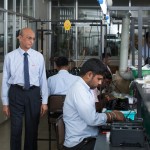There is an urgent need to cut unnecessary costs that hinder Indian businesses. PM Narendra Modi has been travelling far and wide to invite foreign companies to invest and ‘Make in India’ with an assurance that doing business in India is going to be made far easier than it has been so far. From a foreign investor’s point of view, it is not the number of places that India goes up the bottom of the ladder that matters, but the actual position towards the top of that ladder that the Indian government intends to reach. But the more important question in every Indian businessman’s mind is whether this so-called ‘ease’ is only meant for foreign investors with Indian businesses continuing to suffer all the woes.
‘Make in India’, ‘Defence Indigenisation’, ‘Self-reliance’ and ‘Digital India’ are great slogans for creating the hype, and also causes the hungry Indian businesses to salivate. If our PM is serious about enabling and empowering Indian businesses to play in the competitive global market place, everything boils down to competitive costs, whether for local consumption or exports. Let us look at what these costs include. The adage ‘Time is money’ is certainly not understood either in our bureaucracy or government decision-making, and least of all, our honourable judiciary. ‘Delivery time is the essence of the contract’, says a purchase order of a DPSU that takes eight months to process tender bids for a relatively low value item.
‘Ease’ of Funding: ‘Funds, funds, funds’ is the cry of the most MSMEs across the country. Various glorified schemes exist on paper, but rarely made available even to the most successful of entrepreneurs with orders worth crores on hand. An MSME entrepreneur is expected to kneel and beg, and work through the maze of red-tape, only to get a few crumbs thrown to him while companies providing ‘good times in the sky’ get crores even if they are bound to result in NPAs. Private funds are available for budding startups — preferably in the online space— but for the manufacturing industry this comes at a significant cost.
‘Ease’ of Regulations: Tax authorities are accorded enormous powers that are often abused. The sales tax department goes around attaching banks accounts of assesses on flimsy grounds so that it can show inflated revenue collections even if these are bound to be refunded a few years later after judicial intervention. The businesses meanwhile, suffer a huge cost that is never reimbursed, not even the interest on the amount unfairly seized by the government.
Many MSMEs have faced this situation, and have had to take one of these three hard decisions, all of which involve significant financial costs: (a) bribe their way out of it (most MSMEs opt for this solution), (b) go through the lengthy judicial process (very few MSMEs have the courage and patience to go through this) or – for several entrepreneurs, the worst but only option—(c) take the financial hit and shut down. Why should assessment officers be empowered to execute summary assessments overruling evidence in spite of an assessee filing all the required documents? If there is no cost attached to such malpractices of the bureaucracy it makes merry at the cost of the entrepreneur.
Income tax and Central Excise departments are no different. Refunds are rarely made within three or four years leading to loss of interest which is a cost to the entrepreneur. The Legal Metrology Department too has joined the party, confiscating electronic white goods ridiculously classifying them as ‘packaged, commodities’ that require registration with the department.
‘Ease’ of Labour: What about costs imposed by outdated labour laws? Anything and everything can be contested in a labour court, even if an employer has abided by the laws. This leads to litigation costs as well as unproductive wages being incurred in one form or the other, besides fees to consultants and advocates. If labour reforms are only going to target garage operations with less than 40 workmen, does it mean that larger MSMEs will continue to face the woes of running a manufacturing establishment?
‘Ease’ of Infrastructure: Certainly not the least important, infrastructure costs add significant amounts. Shortage of electricity has been a perennial problem in Karnataka for decades, and businesses are forced to operate on DGs which imposes multiple costs if an employee needs to spend three hours travelling to work in a messy city such as Bengaluru, that is a cost due to unproductive time. By the time the much hyped ‘Namma Metro’ achieves full connectivity, it would itself be as congested as the Mumbai trains, which would be self-defeating.
Cost of urban land, provided to foreign investors at a fraction of what is charged to Indian MSMEs, makes the whole business proposition unviable. If any subsidised rates are offered, it comes with ‘hidden’ costs. The lion of ‘Make in India’ will continue to sleep, or subsist with low value addition ‘manufacturing’ using CKD kits of MNCs as long as we fail to look for holistic and long-term solutions involving both the State and Central Governments.
The original article appeared on Deccan Herald.


